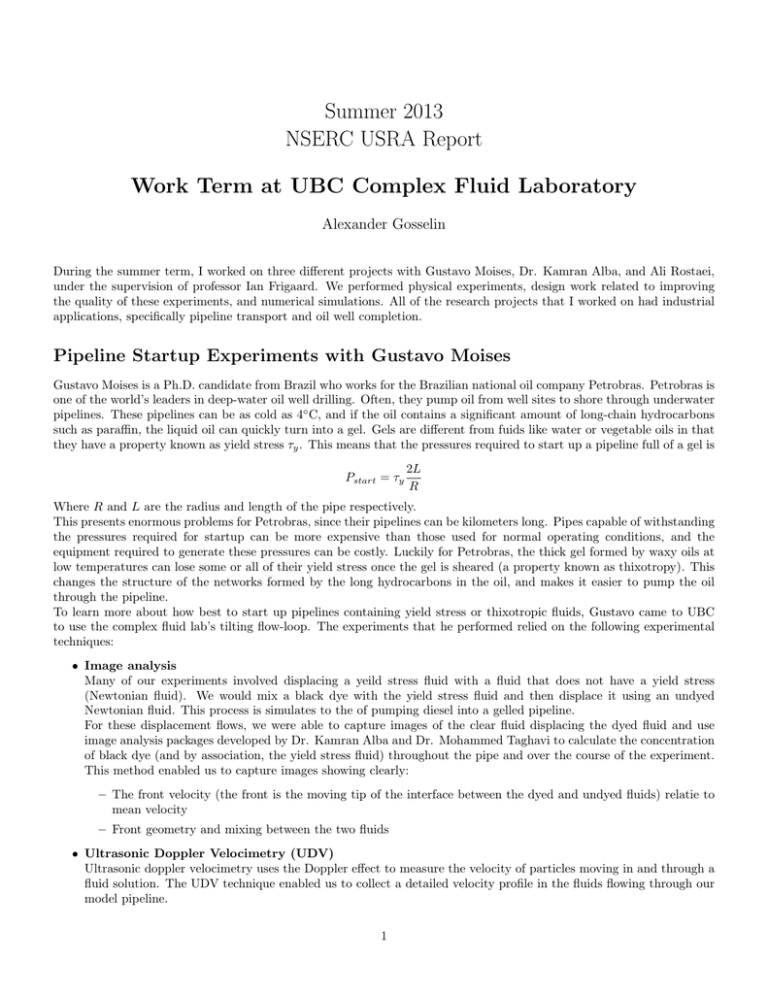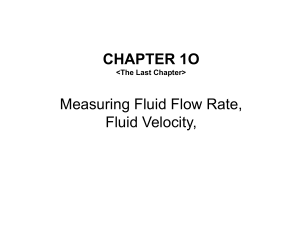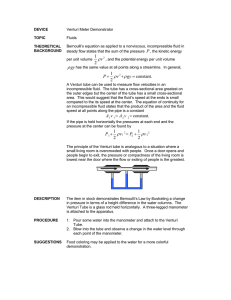Summer 2013 NSERC USRA Report Work Term at UBC Complex Fluid Laboratory
advertisement

Summer 2013 NSERC USRA Report Work Term at UBC Complex Fluid Laboratory Alexander Gosselin During the summer term, I worked on three different projects with Gustavo Moises, Dr. Kamran Alba, and Ali Rostaei, under the supervision of professor Ian Frigaard. We performed physical experiments, design work related to improving the quality of these experiments, and numerical simulations. All of the research projects that I worked on had industrial applications, specifically pipeline transport and oil well completion. Pipeline Startup Experiments with Gustavo Moises Gustavo Moises is a Ph.D. candidate from Brazil who works for the Brazilian national oil company Petrobras. Petrobras is one of the world’s leaders in deep-water oil well drilling. Often, they pump oil from well sites to shore through underwater pipelines. These pipelines can be as cold as 4◦ C, and if the oil contains a significant amount of long-chain hydrocarbons such as paraffin, the liquid oil can quickly turn into a gel. Gels are different from fuids like water or vegetable oils in that they have a property known as yield stress τy . This means that the pressures required to start up a pipeline full of a gel is Pstart = τy 2L R Where R and L are the radius and length of the pipe respectively. This presents enormous problems for Petrobras, since their pipelines can be kilometers long. Pipes capable of withstanding the pressures required for startup can be more expensive than those used for normal operating conditions, and the equipment required to generate these pressures can be costly. Luckily for Petrobras, the thick gel formed by waxy oils at low temperatures can lose some or all of their yield stress once the gel is sheared (a property known as thixotropy). This changes the structure of the networks formed by the long hydrocarbons in the oil, and makes it easier to pump the oil through the pipeline. To learn more about how best to start up pipelines containing yield stress or thixotropic fluids, Gustavo came to UBC to use the complex fluid lab’s tilting flow-loop. The experiments that he performed relied on the following experimental techniques: • Image analysis Many of our experiments involved displacing a yeild stress fluid with a fluid that does not have a yield stress (Newtonian fluid). We would mix a black dye with the yield stress fluid and then displace it using an undyed Newtonian fluid. This process is simulates to the of pumping diesel into a gelled pipeline. For these displacement flows, we were able to capture images of the clear fluid displacing the dyed fluid and use image analysis packages developed by Dr. Kamran Alba and Dr. Mohammed Taghavi to calculate the concentration of black dye (and by association, the yield stress fluid) throughout the pipe and over the course of the experiment. This method enabled us to capture images showing clearly: – The front velocity (the front is the moving tip of the interface between the dyed and undyed fluids) relatie to mean velocity – Front geometry and mixing between the two fluids • Ultrasonic Doppler Velocimetry (UDV) Ultrasonic doppler velocimetry uses the Doppler effect to measure the velocity of particles moving in and through a fluid solution. The UDV technique enabled us to collect a detailed velocity profile in the fluids flowing through our model pipeline. 1 • Computer control of pressure and flowrate sensors We used LabView to control data acquisition devices that compose our experimental apparatus, such as flowmeter, pressure transducer, and cameras. I have learned about these techniques, how they work, how to use them, and their limitations. I also developed some post-processing codeusing MATLAB for use in analysing UDV, flowmeter, and pressure transducer data. Flow-loop redesign with Dr. Kamran Alba The flow loop used by Gustavo in his experiments has some trouble - the tube isn’t entirely straight, and this creates problems while analyzing pictures of the tube and performing particle image velocimetry (PIV) measurements. The experimental apparatus also less closely approximates mathematical models of the processes studied. I worked with Dr. Kamran Alba to design a tube assembly which would guarantee the straightness of the tube for future experiments, while also providing visual access to the tube so that images can be taken of the flows taking place inside. In addition to constraining the tube against bending and buckling, we also made allowance for space to attach instruments to the flow loop. As part of this project, I: • Drafted and presented multiple candidate designs • Invented a means of constraining the tube while simultaneously allowing visual access to the tube along its entire length. In future experiments, this will allow us to shine laser sheets (for PIV measurements) through the tube while taking pictures of the experiment in progress. • Prepared detailed 3D models using SolidWorks and used these to prepare engineering drawings of the components that had designed. • Requested quotes from a plastic fabricator on the construction of the components hat I had designed, and arranged for their fabrication. Viscoplastic Washout Simulations with Ali Rostaei Drilling and completing oil wells involves flows of viscoplastic (yield stress) fluids, specifically the drilling mud pumped to cool the drill bit and balance pressures between the well bore and the rock formation being drilled. When this mud is pumped down the well bore, it passes through a cylindrical steel tube, and as it is pumped back out the mud flows through an annular regio, with steel pipe on the inner surface of the annulus, and a rough rock wall on the outer surface. Holes in the rock wall are called washouts, and they can present problems during well completion, since washouts require extra cement to fill, and may create channels for natural gas to migrate through the well casing to the surface. Annular 3-dimensional flows can be satisfactorily modelled s 2-dimensional channel flows. Ali Roastaei has developed a robust software package for simulating the flow of viscoplastic fluids in these washout structures. I worked with him to run these simulations, and implemented a rough-walled washout geometry based on a Koch snowflake. To do this, I had to learn how to use the Linux operating system and substantially improve my skill at programming in C++. 2





